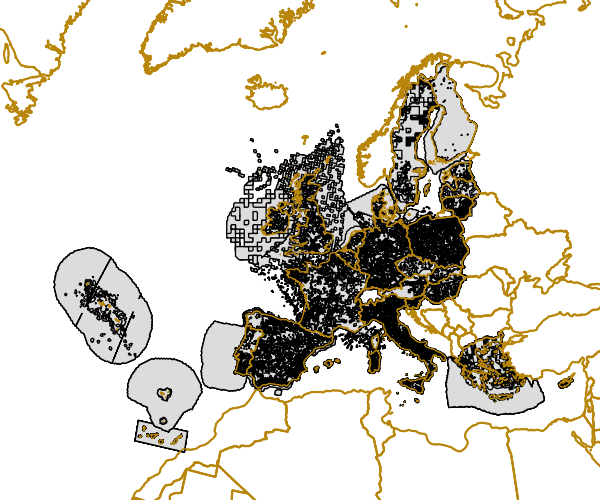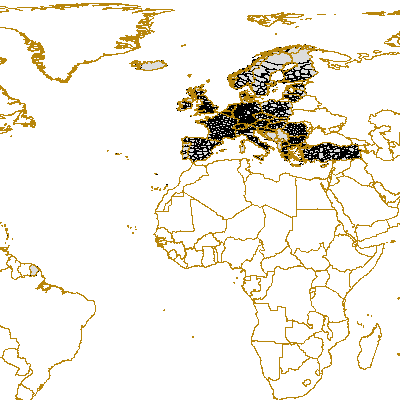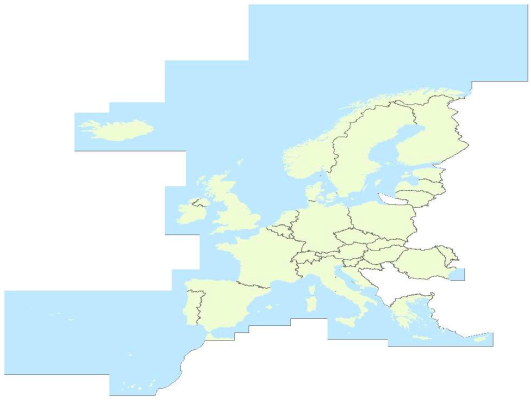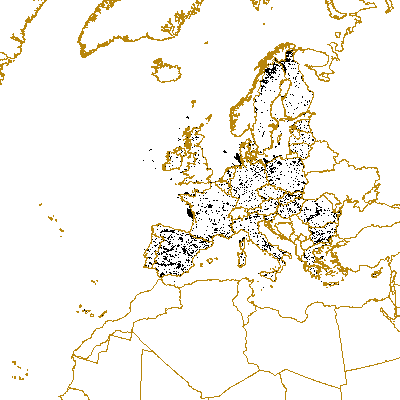2009
Type of resources
Topics
INSPIRE themes
Keywords
Contact for the resource
Provided by
Years
Formats
Representation types
Update frequencies
status
Scale
Resolution
-

ECDDA polygon dataset. Geographical extent covers covers Europe, Russia, Central Asia, Greenland, French DOM-TOM & COM. Polygon data of nationally designated areas.
-

Gridded Distribution of Species as reported during the Article 17 of the Habitats Directive (92/43/EEC) covering the period 2001 to 2006. The data covers the EU 25. All Member States are requested by the Habitats Directive (92/43/EEC) to monitor habitat types and species considered to be of Community interest. Article 17 of the Habitats Directive 92/43/EEC requires that every 6 years Member States prepare reports to be sent to the European Commission on the implementation of the Directive. The Article 17 report for the period 2001-2006 for the first time includes assessments on the conservation status of the habitat types and species of Community interest. Information on the data quality of the 2001-2006 reporting round is available at http://bd.eionet.europa.eu/article17.
-

The 'GISCO NUTS 2006' dataset represents the NUTS regions by means of region, arc and point topology. The NUTS geographical information is completed by attribute tables and a set of cartographic help lines to better visualise multipart polygonal regions. The NUTS nomenclature is a hierarchical classification of statistical regions defined by Eurostat. The NUTS classification subdivides the EU economic territory into 3 statistical levels. The Regulation (EC) No 1059/2003 of the European Parliament and of the Council on the establishment of a common classification of territorial units for statistics (NUTS) was enforced the 11 July 2003. This regulation provided the NUTS classification with a legal background. Since then, 12 new countries joined the European Union. The NUTS regulation was officially enforced in these 12 countries the day of their accession to the EU. A non official NUTS-like classification has been defined for the EFTA countries, Croatia and Turkey. For further information about the NUTS classification please check the RAMON Eurostat site at http://ec.europa.eu/comm/eurostat/ramon/nuts/home_regions_en.html At present, six scale ranges (100K, 1M, 3M, 10M and 20M, 60M) are maintained in the GISCO geodatabase. The polygon and boundary classes delineate the regions while the points provide a label for each region. Associated tables contain basic information such as the region's name. This feature class represents the polygon geometry of the 1:100.000 scale level of the NUTS regions. This shapefile was modified by the ETC-LUSI with the purpose of including this dataset into the LEAC System.
-

EuroRegionalMap is a Pan-European topographic vector dataset at scale 1: 250000 covering 32 European countries: 26 EU Countries (Bulgaria not included), 4 EFTA countries, the Republic of Moldova and Liechtenstein. It is seamless and harmonized across boundaries.It is a seamless1 and harmonised data and is produced in cooperation by the National Mapping and Cadastral Agencies of Europe, using official national databases. EuroRegionalMap is ideal for a wide range of uses, including cartographic publishing and backdrop visualisation, or in combination with other datasets for marketing planning and socio-economic analysis, environmental analysis, and transport management. Themes: a) Administrative (administrative boundaries, administrative areas) b) Hydrography (well, coastline / shoreline, foreshore, island, sea, aqueduct, lake / pond, reservoir, spring / water hole, waterfall, watercourse, dam / weir, lock, glacier, snow field / ice field, wetland) c) Transportation (railway, interchange of motorways, road, control tower, level crossing, ferry crossing, ferry station, entrance / exit, railway station, vehicle stopping area / rest area, pier / wharf / quay, airport / airfield, heliport, runway) d) Settlements (built-up area, named location)
-

This dataset was built from the original Natura 2000 vector. The raster grid is aligned with the EEA reference grid GeoTIFFs generated by GRASS, according to the GeoTIFF Revision 1.0 specifications at http://www.remotesensing.org/geotiff/spec/geotiffhome.html. The information displays if there is or not Natura 2000 sites under each specific pixel zone.
-

This dataset was built from the original Natura 2000 vector. The raster grid is aligned with the EEA reference grid GeoTIFFs generated by GRASS, according to the GeoTIFF Revision 1.0 specifications at http://www.remotesensing.org/geotiff/spec/geotiffhome.html. The information displays if there is or not Natura 2000 sites under each specific pixel zone.
-

EuroBoundaryMap (formerly known as SABE - Seamless Administrative Boundaries of Europe) provides a European geographic database for administrative and statistical regions that will be maintained at the source level by the National Mapping and Cadastral Agencies (NMCAs). EuroGeographics is providing harmonized access conditions for this reference data. EBM v4.0 (1:100.000) offers the combined strength of detailed European administrative units and the linkage to corresponding NUTS codes. Feature catalogue: a) Administrative units (Area controlled by an administrative unit [EBM_A]) b) Label points (Reference point for the main area of an administrative unit, can be used for labelling purposes [EBM_P]) c) Administrative boundaries (A line of demarcation between administrative controlled areas [EBM_L]) d) Derived units on higher national levels (Administrative units on higher hierarchical levels (USE-Regions [USE_X]), Derived national NUTS regions [NUTS_X]) More details are available in EuroBoundaryMap_v40_Specification.pdf
-

EuroGlobalMap is a topographic dataset that covers the EU (except Bulgaria), Albania, Andorra, Croatia, Faroe Islands, Gibraltar, Greenland, Iceland, Liechtenstein, Moldova, Monaco, Norway, San Marino, Serbia, Switzerland, Ukraine and Vatican at the scale 1:1 Million. It is produced in cooperation by the National Mapping Agencies of Europe, using official national databases. Thematic layers: a) administrative boundaries (administrative boundaries and administrative areas) b) hydrography (coastline / shoreline, foreshore, island, water (except inland), lake, reservoir, spring / water hole, watercourse, dam / weir, glacier, snow field / ice field, land mass) c) transportation (railway, road, ferry crossing, ferry station, entrance / exit, railway station, airport / airfield) d) settlements (built-up area) e) elevation points (height point) f) named location (named location (point and text feature)).
-

Consolidated raster containing the original CDDA polygons.
-

As a permanent service of Eurostat, GISCO: promotes and stimulates the use of GIS within the European Statistical System and the Commission; manages and disseminates the Geographical reference database of the Commission; acts as a reference centre concerning GIS; promotes geo-referencing of statistics and collaboration between national statistical institutes and mapping agencies; pursues and ensures standardisation and harmonisation in the exchange of Geographic Information; co-leads the INSPIRE initiative on the introduction of a European Spatial Data Infrastructure. Within the framework of the GISCO project, an extensive geo-referenced database has been developed. One of the main topics of the GISCO mandate is to extend, maintain and update this database. List of data sets offered by GISCO per ISO 19115 topic category (short name in []): a) Farming: farm accountancy data network [FADN] b) Biota: Natural Vegetation [VEGT], Biogeographical Zones [BIOG], Biotopes [BIOT] c) Boundaries: Territorial Units for Statistics (NUTS + Statistical Regions) [NUTS], Communes [COMM], Subcommunes [SCOM], Administrative regions [ADRG], Countries [CNTR] d) Climatology / Meteorology / Atmosphere: Climate [CLIM] e) Economy: Fishing Areas [FISH] f) Elevation: Digital Elevation Model [DEM], Bathimetry [BATH] g) Environment: Land Quality [LNQU], Designated Areas [DSIG] h) Geo-scientific information: Soil Erosion Risk [SOER], Geology Geomorphology ErosionTrend [ERTR], Soil [SOIL], Sediments Discharges [SDDS], Coastal Erosion [COER] i) Imagery/Base maps/Earth cover: Land Cover [LCOV] j) Inland waters: Water Patterns [WTPT], Lakes [LAKE], Watersheds [WTSH] k) Locations: Geographical Grid [GGGR], LUCAS [LUCA], Settlements [STTL], Gazetteer [GAZZ] l) Oceans: Coastline boundaries [COAS], Sea Level rise [SELV] m) Planning/Cadastre: Inter Regional [IREG], Leader Zones [LEAD], Less Favoured Areas [LFAV], National Support [NTSU], Structural Funds Zones [STFU], Urban Audit [URAU] n) Society: Population [POPU], Degree of urbanisation [DGUR] o) Transportation: Airports [AIRP], Ferry links [FERR], Ports [PORT], Road infrastructure [ROAD], Railway infrastructure [RAIL] p) Utilities/Communication: Nuclear Power [NUPW], Energy Production [ENPR], Energy Transport [ENTR] Further details can be found in gisco_naming_conventions_20090831.pdf
 RUC Geo-Data catalogue
RUC Geo-Data catalogue